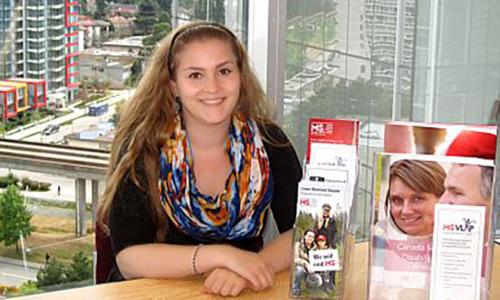
My routine began like clockwork. I used my electronic key to open the door and enter the room. Every time I looked at my photo ID on the key I was reminded of the two day orientation in the beginning of January; the only time all sixty something of the co-op students were together. Now, it being the second semester and past filing season, only around a dozen of us remained. After the first semester ended our seating arrangements changed and we now all worked together on the same floor; cubicles side by side.
I started up my computer and got myself prepared to start the day. I opened up the two information system programs Canada Revenue Agency (CRA) uses. I had about five different passwords to remember. One to login into the computer, one for signing into the information systems, one for creating our timesheets and a few more that I couldn’t recall at the moment. I often had to pause and think about which password I was supposed to use for what system. The first taxpayer information system I opened was newer and was user friendly. The other information system was an older program but was very reliable for giving up-to-date information. I opened up a few browsers and pulled up my bookmarked pages that I use to research.
Although my shift began at 8:00am, I didn’t officially begin to take phone calls until 8:15am. If anyone wondered why the call centre opened at 8:15am, the first 15 minutes of each day is reserved for reading emails and CRA news updates. I logged onto the phone system at 8:15am sharp and the phone rang immediately. That in and of itself informed me it would be a busy day. I cleared my throat before answering. This job required a lot of speaking and I always had water on hand.
“Individual Income Tax, how may I help you?” I used the same greeting for each of my calls.
The taxpayer politely asked how I was doing. I responded and reciprocated the question. After exchanging pleasantries she informed me that she wish to check on the status of her return. This was one of the most common questions, and one that had many possible answers. Other common requests included changing mailing addresses, clarification about the explanation of changes section on the notice of assessment and enquiries about the disability tax credit (DTC).
I liked to think of each call I received as a mystery. The taxpayer was confused and it was our duty to investigate and solve the problem. Many of my phone calls were answered within less than five minutes. Other calls were more complex and took fifteen or twenty minutes. I have only ever had to hang up on a handful of people. It was a low percentage rate when you considered I had taken over 7,000 calls in my eight months. The only instances where I have disconnected a call were when the individual on the other line was using abusive language.
I informed the taxpayer that I would need to ask a few security questions in order to gain access to her account. As we dealt with sensitive tax information, it was imperative we be diligent with the security questions. When a person was unable to clear confidentiality, I informed them they needed to call back with the appropriate information. When that was not a viable option, I offered to make a counter appointment at their tax service office where they bring photo identification. When that didn’t work, I advised them to make their request in writing and mail or fax it to CRA.
I smiled inwardly as I saw that her return was being mailed out today and she would be receiving a refund. It was always nice to convey good news. “Excellent,” she responded. I asked if there was anything else I could help her with.
“Yes. Now that you mention it, how much is my payment that comes every few months?”
I knew immediately that her question was not one I could answer. Any reoccurring payments were not associated with the General Enquires line. I probed deeper to figure out where I would have to direct her call. I found out that she wasn’t referring to the Goods and Services Tax (GST) credit payments or the Working Income Tax Benefit (WITB) advance payments or the Ontario Sales Tax Transition credit. These were the most common federally issued payments. She did not know the name of the payment and I was stumped when these payments did not match her criteria. I did a search in the internal technical help guide and the public CRA website but couldn’t find anything. I knew the limit of my knowledge and research abilities. There was no way I could provide an answer without some assistance. I asked her to hold and while she was listening to piano music I locked my computer and walked across the floor to a resource officer. My calls are answered efficiently and with either the right answer or a point in the right direction if they called the wrong line.
When I told my resource officer what the taxpayer was looking for she was stumped. I repeated a few of the key points the taxpayer had mentioned in the hopes that it would trigger something. After giving it some thought, my resource officer said that what the taxpayer was referring to was the Alberta Family Employment Tax credit. Eight months of working at CRA and I had never heard of it; nor should I have reason to as it was not a General Enquiries issue. I thanked my resource officer and returned to the call, happy that the mystery was solved. I told the taxpayer the name of the payment and gave her the correct phone number to call.
This situation was just one example of how CRA worked as a team. We received extensive training about income taxes but there was only so much a Tier 1 phone agent could know. The cardinal rule at CRA was if you couldn’t find the answer in an efficient manner on your own, put the taxpayer on hold and ask for assistance. If the situation calls for it, we can arrange for a client call-back. Call-backs were only necessary when researching an enquiry could not be completed within a suitable timeframe.
The day continued as usual. I stood up in my cubicle to relax the tension in my lower back that hours of sitting can create. The computer monitor and keyboard easily adjusted so the phone agents can work standing up. As I looked around, at least half of the co-ops were also standing. I always found it surprising the change in the noise level from sitting to standing. The room we worked in was designed to absorb sound, but there was a constant din in the background. After a short while of working at the call centre I learned to tune out the background noise and could now only notice it when I concentrated on it.
At 12:00pm I logged out of the phone system and went to our meeting room. There was always a few minute wait as each agent wrapped up their phone calls. When the majority of us were seated, my team leader went over some housekeeping issues and the discussed the bridging program. This program was when CRA hired co-op students as full time government workers after graduation. My resource officer wrapped up the meeting by discussing some technical issues. She then informed us she would be sending us some useful links we could use during our research. I had over forty links book-marked as favourites on my computer and was about to add a few more.
My team dispersed from the meeting room and returned to the phones. After a few more address changes and refund enquiries it was time to call it a day. I logged out of the phone system, closed all of my browsers and shut down the computer. I gathered my belongings, scanned the desk to make sure everything was put away, and headed for the door. I waved goodbye to people who were still on phone calls and began my commute home.














